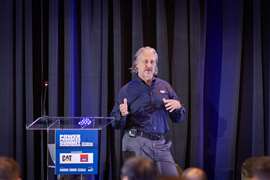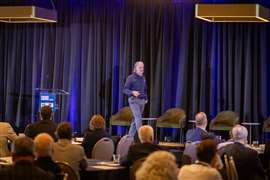Read this article in Français Deutsch Italiano Português Español
Caterpillar exec: ‘Problem solvers’ required to deliver energy transition solutions
04 November 2024
At the start of his keynote presentation on day two of the Power Progress Summit, held Oct. 1-2 in Chicago, Ill., Rob Hoenes, senior vice president for Caterpillar’s Electrification and Energy Solutions Division, noted the pride expressed by previous speakers in having “the best engineering team” in the industry.
 “All of us have to be prepared to offer [multiple] options, depending on what the requirement is for the individual market.” – Rob Hoenes, Caterpillar (Photo: Eason Photography)
“All of us have to be prepared to offer [multiple] options, depending on what the requirement is for the individual market.” – Rob Hoenes, Caterpillar (Photo: Eason Photography)
“Being an engineer myself, I really think this is a moment for the engineer – this transition that we’re going through,” he stated. “So, I don’t think it’s a waste to celebrate what those people do.”
Yet rather than echo their sentiment, he went on to argue that Caterpillar has the “best problem solvers.” The energy transition requires involvement from more than engineers, he said, to deliver on the company’s mission to “help our customers build a better, more sustainable world.”
Multiple options required
“Helping the customers indicates subordination to where they are and what they’re trying to accomplish – not some altruistic or bigger motives, but actually going on that journey in a very practical way with our customers,” Hoenes told summit attendees. “It’s also about helping them through the uncertainties and the disruptions that are inherent to the energy transition.”
The industry has the engineers and the technology to make battery-electric machines, he continued, but solving the challenges requires a broader approach.
“Every customer has different motives and is in a different place, not only geographically, but from a business standpoint. It’s all going to factor into where they start on this journey,” he said. “And so, the fundamental approach that we’re taking is to start where they are and offer them steps where they can start moving according to their pace and their business needs through that transition.”
This means multiple options are required, ranging from alternative fuels to electrified solutions. “All of us have to be prepared to offer those options, depending on what the requirement is for the individual market,” Hoenes noted.
For Caterpillar, this includes not only providing those options, but the power sources needed to support them on the jobsite. This broad agenda is where the problem solvers come in.
 Hoenes believes the real opportunity in the energy transition will be in the ability to deliver more value and get work done more efficiently. (Photo: Eason Photography)
Hoenes believes the real opportunity in the energy transition will be in the ability to deliver more value and get work done more efficiently. (Photo: Eason Photography)
“It takes most of the capability in Caterpillar… to be able to cross all the way from the power to the machines, to the components and all the energy distribution in between. That takes the entirety of a very large organization to be able to deliver that,” said Hoenes, “as well as an even bigger underlying supply base.”
Opportunity to deliver more value
What Hoenes said he’s enjoyed the opportunity the energy transition has provided to rethink and reimagine how work gets done.
“That’s kind of what our customers really need from us. And I also think that’s some of the opportunity that goes unseen,” he stated.
He cited the D7E electric dozer, for example, which was one of Caterpillar’s first electrified products. “That’s probably 20-25 years old now. So, our progress in electric motors and power electronics has been long in the making.”
While there are fuel savings and other emissions reductions that came with it, Hoenes said the machine is also “a performer.”
“You can put power in the form of torque and speed wherever you want it,” he noted. “That’s got way bigger implications than just emissions.
“To me, [emissions reduction is] a secondary benefit. It’s great that we get it, but the real opportunity here is to deliver more value and get work done more efficiently,” Hoenes said, “whether that be with a diesel product or alternative fuel or hydrogen or electric.”
Identifying and delivering that value means even more opportunity ahead for engineers and other problem solvers. “I can’t imagine a better time to be part of this industry than right now,” Hoenes commented. “It probably hasn’t happened for maybe 40 to 50 years since we’ve had a transformation on this scale.”
POWER SOURCING GUIDE
The trusted reference and buyer’s guide for 83 years
The original “desktop search engine,” guiding nearly 10,000 users in more than 90 countries it is the primary reference for specifications and details on all the components that go into engine systems.
Visit Now
STAY CONNECTED




Receive the information you need when you need it through our world-leading magazines, newsletters and daily briefings.
CONNECT WITH THE TEAM













